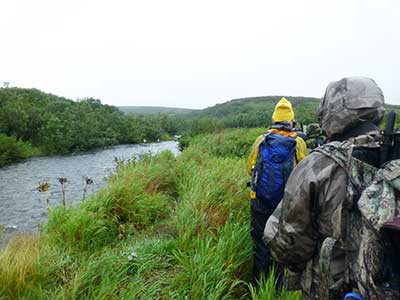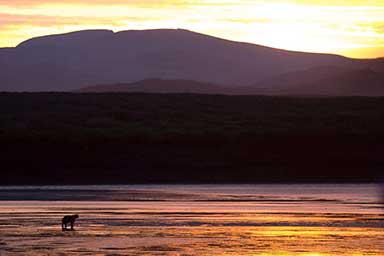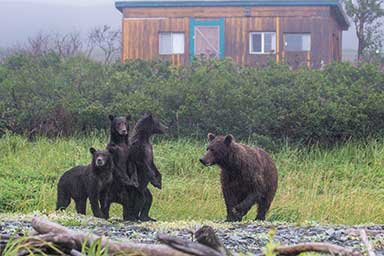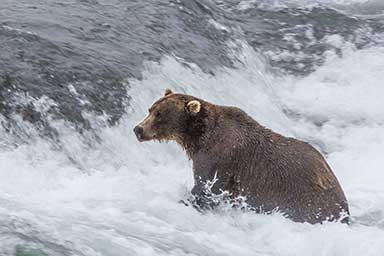Alaska Fish & Wildlife News
September 2014
Even When it’s Bad it’s Good at McNeil
Bear Viewing When it’s Slow

McNeil River falls roared just out of sight as we trudged closer, trying not to stumble on the slippery, muddy trail. Photographs we had seen of dozens of large brown bears fishing in this famous spot floated in our imaginations. Then we were there. Scenic whitewater cascaded over boulders and down the river. But, there were no bears. Not a single one.
Samantha McNearny (Sam), our guide, had warned us. Bears at the falls are after salmon and we happened to be there, in mid-August, between fish runs. A bright silver (coho) salmon threw itself forward, a harbinger of good viewing in days ahead. Still, there was no denying present disappointment. Iris, who had flown to Alaska from Israel for world-renowned bear viewing, first at nearby Brooks Camp in Katmai National Park and now here at the State of Alaska’s McNeil River State Game Sanctuary, lamented on our trek back to camp “Of course – I’m here, so the bears aren’t.”
Bears were around us, just not in that place right then. They were dispersed among and hidden by the long late summer grasses and sedges, willows and alders, and landscape blanket of tall hot pink fireweed, roaming to find fish. This meant we roamed to find them. We had been thrilled to see one bear close by earlier that day.
Thomas Griffin, who has worked at McNeil for 15 years and is currently the onsite manager, likens the varied viewing experiences through the summer to different types of music concerts. “The falls in July is a rock concert,” he says, noisy and intense with bears. At other times, it is more like a symphony, he says while air playing the violin, where you hear the strains of an individual instrument or refrain, and the music builds to a dramatic moment. You have to come to this wild place prepared to accept what it has to offer at that time.
Perhaps I should emphasize those words “wild” and “prepared.” This is not high-volume visitor, comfortable accommodations bear viewing, where a tour operator takes care of your every need. This is backcountry camping, where you must bring your own gear and meals and take care of yourself. For camping it is actually pretty posh—there is a well-appointed shared cooking cabin with a woodstove for warmth and drying gear, tables, propane stoves, and a good library of information, supplies donated in part by the nonprofit group Friends of McNeil River. A sauna, using pond water, is available. But, visitors sleep in their tents. Drinking water must be hauled and filtered. Hip waders, good balance, and sturdy hiking legs are needed to transport you to where you might likely see bears. You must be willing to endure the vagaries of sometimes stormy Alaska Peninsula weather.

Entrance to this wild landscape begins with a floatplane ride, flying 100 miles west from Homer, Alaska. The plane soars over what seem vast untouched areas clouded in mist, and passes near active Augustine Volcano before landing on a lagoon protected from ocean waves by a narrow gravel spit. We line up to unload gear and it is hauled in wheelbarrows through the rain to the nearby camp, a few cabins and outhouses and tent sites on the edge of open country.
We are beginning what Tony Kavalok calls a unique experience among bear viewing opportunities. Kavalok is an Assistant Director of the Alaska Department of Fish and Game’s Division of Wildlife Conservation and supervises the state’s refuges program, which includes 32 special areas, refuges, critical habitat areas, and sanctuaries. He says most other bear viewing programs are designed to accommodate larger numbers of visitors, usually from out-of-state, who want a more comfortable, full-service tour that doesn’t require outdoor skill or experience. “McNeil,” he says, “focuses on providing potential viewers, especially outdoor-savvy Alaskans, with a relatively affordable and natural viewing experience where they can safely see big brown bears up close.” I realize that I fit this model perfectly; I don’t have money for or interest in lodge-based options or large groups, I love camping and feeling part of rather than separated from the lands I visit–but I wouldn’t feel safe going on my own to a place with this concentration of bears.
An annual report notes McNeil hosts the largest gathering of brown bears in the world, as they congregate to feed on migrating salmon. On average, 94 individual bears are identified by staff each year; the average index count at the falls (during times when bears usually fish the falls) is about 49 bears. The Alaska Legislature created the sanctuary in 1967 to provide permanent protection for the brown bears, as well as fish and other wildlife populations, and their habitat in this 200 square mile area, and to maintain and enhance this unique bear viewing opportunity.
To protect the bears, and the experience, access to McNeil is by permit, with core 4-day viewing permits allocated by lottery. In 2013 Alaska residents purchased 68% of a total of 189 permits of all types; the sanctuary saw 890 bear viewing days while hosting visitors from seven countries. While getting here can be expensive, the permits themselves are not; in 2013 it cost $25 per person to apply to the lottery, and the fee for the viewing permit itself was $150 (or about $37 per day of viewing and camping) for Alaska residents, and $350 for nonresidents. For that you get care of the camp: structures are maintained, firewood is available, outhouses are cleaned, and the garbage is dealt with. You also get an all-day armed and experienced guide.

Sanctuary guides are proud of the program’s safety record; in more than 40 years, they haven’t had to fire on and no one has been hurt by a bear. “The key is consistency,” says Griffin. The program’s goal is to make the human presence unobtrusive and predictable for bears, so the bears can be bears, and humans can delight in seeing what they do.
This involves a lot of people management, which starts with our orientation in the cook cabin once we get to camp. Sam emphasizes that the only “human” area where bears are not allowed is the very narrow strip of cabins and tent sites. “That line of alders,” she says, pointing to bushes about 30 feet away, “is the edge of camp.” In general, visitors are not to leave camp without a guide, but may go in groups of at least three to get water at the designated creek, or walk the spit, if they get prior approval from the staff person on duty. Sam emphasizes that everyone needs to assist in the effort to keep a clean camp so as not to attract bears; there is to be no food in the tent, burnable garbage goes in one trash can for burning, and unburnable garbage that will be flown out in another can.
There are usually no more than about 10 to 20 permitted visitors at any one time, plus the McNeil camp staff and a few other visitors, such as myself, who are doing some sort of work: I’m here as staff for only two days of viewing to learn and write about the viewing experience. It’s interesting to me that all visitors in this particular group, including me, are either middle-aged or older. All but two are Alaskans.
We are mostly strangers to each other, but we begin to form a quick temporary community as everyone gets settled. Two visitors have been here before; for the rest of us it is a new, probably once-in-a lifetime, experience. “So, here’s the tent, now what do I do with it?” asks Iris, who rented gear from an outfitter in Homer. Don and I enjoy helping her set it up. Tom, an outdoorsman and hunter from Colorado, figures out her water filter and shows her how to use it.
After a stormy night, our foray into the wilds in search of bears the next morning is timed around expected high tides. We need to cross Mikfik Creek before it is drowned in high water, and need to be present when the fishing is right for the bears. This dance to the music of the land changes a little every day.

We leave camp in a single line snake, part of efforts throughout the day to stay together as a group so we always seem to be only one entity to the bears. We walk about an arm’s length from each other, along a narrow muddy trail. A mile and half later we come to Mikfik Creek, where an adult female bear stands in the shallow crossing area. Sam recognizes her by a nick mark. We keep our distance and the bear eventually moves off upstream. We wade through the water and on the other side spot her resting near a stand of willows and alders. Tom, the visitor from Colorado, invites me to look through his scope (the first of many times I and others are thankful he is so generous with his equipment). I am struck by the way the bear’s wet streaked fur seems to mimic the arc of the wild grasses. Sam encourages us to settle in near the bank of the creek and wait. We put on additional warm layers, snug our coat cuffs and rain hats against the drizzle, pull out camping chairs, and munch our lunches. There is light conversation, but mostly we listen to the wind, the rippling water, and the gulls, and watch for bears.
The same bear reappears, catches a fish upstream and climbs into alders on the opposite bank to eat, pestered by gulls. Then she walks down the creek right toward us. She pounces in water, pulls up a multicolored spawned-out chum salmon, and stands in the creek, about 25 feet away, holding the fish with one paw as she eats. When finished, she ambles down the creek, around a corner and into brush, and is gone.
That was thrilling. But, for a long time after, gulls and harbor seals are our only entertainment. So, we make our way to the falls, knowing the likely disappointment, and then return to camp, tired legs thankful for a boat ride across the lagoon, saving us the walk around. At camp, a surprise is wandering in. After what seemed the end of the day’s music, it returns in beautiful harmony and rhythm after dinner as we watch a majestic bear stroll along the tideline amid a dramatic sustained pink and purple sunset. It is a rising crescendo in a great natural concert hall.
On the following day of viewing, with Griffin as our guide, we begin by watching a family group on the tidelands just off camp, a mother with two cubs of the year. The weather is chilly and binoculars are needed, but it is fun to see the mom teaching her young how to catch fish, and the cubs playing together with a stick. We return then to Mikfik Creek but catch only glimpses of bears in the distance. I go back to camp while others head to the falls, with new visitors who haven’t seen them yet. “Of course,” as Iris might say, I wasn’t there, so a bear was. It was just one bear, a large male, but Tom was pleased he caught the iconic McNeil experience and picture of a big bear fishing for bright jumping salmon in whitewater: “It’s what I came for,” he said.

Once again, as evening falls back at camp, we have another wonderful surprise: A mother and her three yearlings rustle around nearby tidal vegetation seeking spawned out chums left there by the tide.
The next morning, my day to leave, I envy those headed out for another day of viewing. As the group prepares to hike out of camp, I ask Iris if the reality of what she found was worth coming. She pauses for a moment and says that as it was happening it was a lot to absorb. But looking back on it, she says, “It was fantastic.”
“Even with the fewer bears, it made each viewing more special,” says Eric. He and his wife, Robin, have lived in Alaska for 33 years. They have traveled the world, viewing wildlife in Africa and many other places. They’ve also been to Brooks Camp. Eric says Brooks and McNeil offer different experiences and he’s glad for both. Brooks is set up for a larger number of visitors who can get a more comfortable experience. It has a 60-spot campground and a lodge where even campers can get meals and showers. The set-up at McNeil, Eric says, is “the perfect combination of backcountry and convenience.” Both say they enjoyed the hiking exercise and would not have wanted to share this type of experience with more than the number of people who were there.
“I kind of like being out in the middle of nowhere” says Robin. “It’s really stunning.” The bears, Eric says, were clearly acclimated to humans, but in a good way: “It wasn’t like they liked humans or wanted to be around them, (just that) they were comfortable with them.” Only at a zoo could you get that close to a brown bear, he says, and then the bear isn’t wild. McNeil, he says, “was a truly wild experience.”
I enjoy the mystery of knowing bears and other wildlife are present even when I can’t see them, and the wonder of those moments when they appear. I came to McNeil at the right time for that experience. In total (including glimpses), we saw 10 bears on my first viewing day and 11 the next. I caught, if not a full symphony, at least something like beautiful chamber music in the interplay of the harmonic instruments of land, water, and wildlife. The experience will play in my memory forever. Still, I enjoy many different types of music. I admit I’d love to make it back some day for the rock concert.
Patti Harper is a writer and editor with the Alaska Department of Fish and Game’s Division of Wildlife Conservation. Thanks to Kim King Jones, a division biologist, for sharing her pictures for this story.
Subscribe to be notified about new issues
Receive a monthly notice about new issues and articles.
